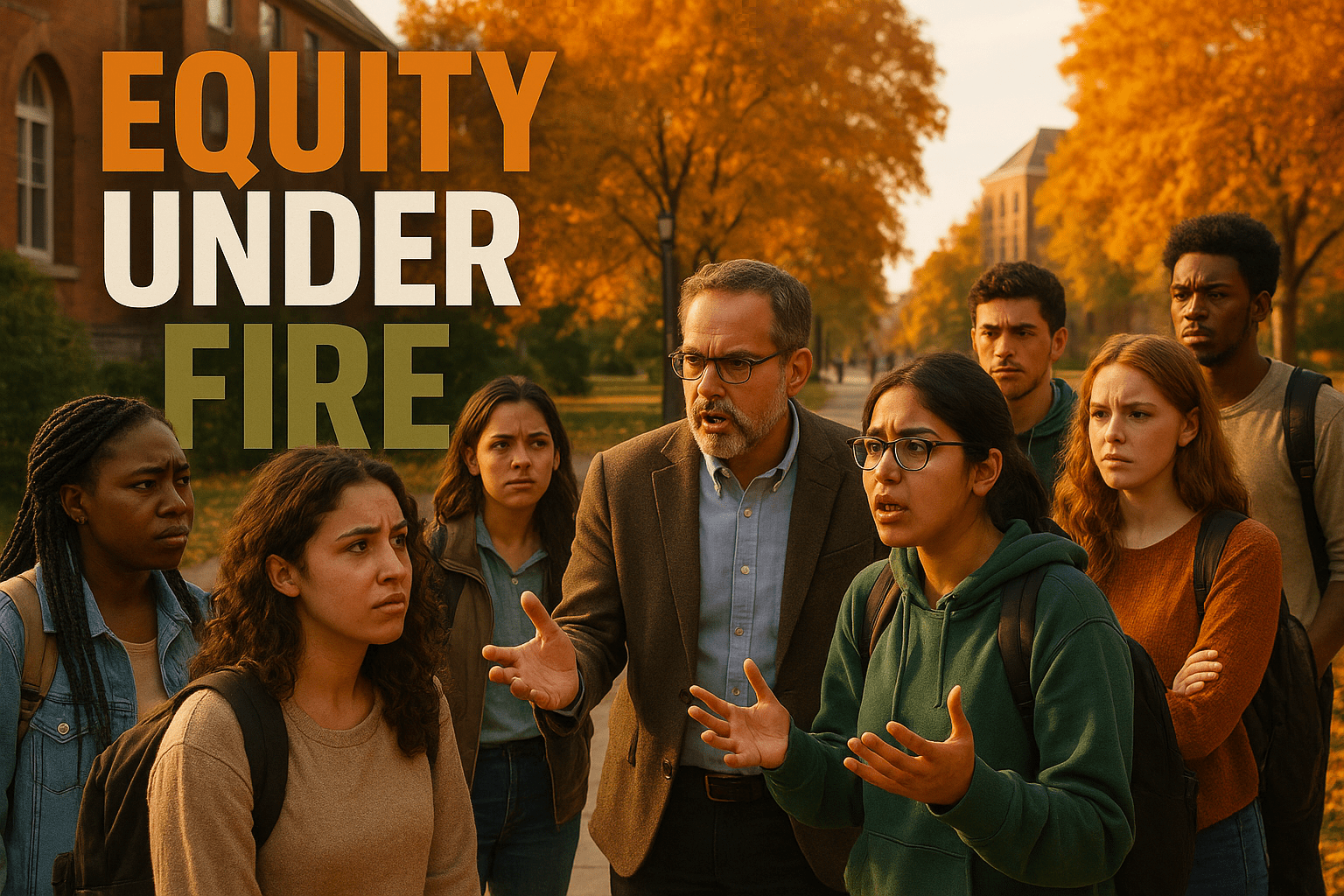

DEI Under Fire: A Battle for Equity
By Darius Spearman (africanelements)
Support African Elements at patreon.com/africanelements and hear recent news in a single playlist. Additionally, you can gain early access to ad-free video content.
DEI Initiatives Under Attack
The Trump administration has been actively working to reshape higher education, particularly by targeting Diversity, Equity, and Inclusion (DEI) programs. This effort has led to federal investigations and policy changes at numerous universities across the nation. More than 50 universities are currently facing federal investigations regarding their DEI programs (nbcwashington.com). This widespread scrutiny highlights a significant shift in the landscape of higher education, where initiatives aimed at fostering inclusivity are now under intense political and legal pressure.
Universities Under Federal DEI Investigation
Both President Trump and Virginia Governor Glenn Youngkin have publicly stated that DEI programs are “illegal” (vpm.org). However, legal experts, such as University of South Carolina law professor Derek Black, contend that there is nothing inherently illegal or unconstitutional about having a DEI office (vpm.org). This disagreement underscores the contentious nature of the debate surrounding DEI, with differing interpretations of its legality and purpose. Federal litigation has been initiated by various groups, including the American Association of University Professors, to challenge Trump’s DEI-related executive orders (vpm.org). These legal battles reflect the deep divisions over the role of DEI in educational institutions and society at large.
The George Mason University Standoff
George Mason University President Gregory Washington has found himself at the center of this controversy. He has steadfastly refused to apologize for his commitment to DEI programs, despite significant pressure from the Trump administration (newsone.com). The Department of Education’s assistant secretary for civil rights, Craig Trainor, alleged that Washington “waged a university-wide campaign to implement unlawful D.E.I. policies that intentionally discriminate on the basis of race” (newsone.com). This accusation forms the basis of the federal scrutiny directed at George Mason University.
The Department of Education demanded that Washington issue a personal public apology for his dedication to DEI programs by September 1st, a request he unequivocally refused (newsone.com). Washington’s attorney, Douglas Gansler, countered these claims, asserting that no job applicant had been discriminated against by GMU. Furthermore, Gansler stated that the Office for Civil Rights (OCR) had not identified any individual who had experienced discrimination, rendering the claim of a Title VI or Title IX violation a “legal fiction” (newsone.com). This legal back-and-forth highlights the core of the dispute: whether GMU’s DEI policies genuinely led to discriminatory practices.
Understanding DEI and “Unlawful Policies”
Diversity, Equity, and Inclusion (DEI) programs are initiatives designed to promote fair representation and treatment for individuals from various backgrounds, including different races, genders, and other identities, within educational and employment settings. These programs aim to create environments where all individuals feel valued, respected, and have equal opportunities. Virginia colleges and universities are experiencing federal pressure to end these policies that promote representation from various backgrounds (whro.org).
“Unlawful DEI policies” and “racial preferencing” refer to practices within DEI initiatives that are alleged to violate civil rights laws by giving preferential treatment based on race or other protected characteristics, rather than merit. The administration’s stance is that such policies are discriminatory. Executive Order 14173, issued on January 21, 2025, bans all DEI and DEIA policies, including programs, grants, or hiring practices by federal contractors and subcontractors that are perceived by the administration as violating civil rights (gmu.edu). Education Secretary Linda McMahon has stated that students must be assessed according to merit and accomplishment, not prejudged by the color of their skin, emphasizing a commitment against racial preferencing (krvs.org).
The Trump Administration’s Timeline and Impact
The Trump administration initiated significant actions affecting DEI policies, notably with Executive Order 14173 on January 21, 2025, which banned certain DEI practices within the federal government and its contractors (gmu.edu). This order has led to widespread rollbacks of DEI policies in public institutions, including universities, and investigations into over 50 universities for alleged “unlawful DEI policies” (krvs.org). These efforts appear to be ongoing and are influencing policy changes in the current landscape.
George Mason and Old Dominion Universities are among the latest Virginia universities to make or propose changes to their DEI policies to align with President Trump’s January 21 executive order to end DEI efforts within the public sector (whro.org). The University of Virginia’s Board of Visitors, for example, voted to dissolve its Office of Diversity, Equity, Inclusion and Community Partnerships on March 1st (whro.org). These actions demonstrate the ripple effect of the administration’s stance on DEI, forcing institutions to re-evaluate and often dismantle their existing programs.
Targeting Black Leadership
The pressure from the Trump administration on DEI initiatives has led to resignations and policy changes at various universities, with concerns raised about targeting Black leadership. The American Association of University Professors stated that “Singling out a Black leader in this way is not only unprecedented but also deeply troubling” (newsone.com). This statement underscores the perception that these actions are not merely about policy, but also about undermining specific individuals, particularly those from marginalized groups.
Former University of Virginia President James Ryan resigned earlier this year due to attacks from the Trump administration over the school’s DEI policies (newsone.com). Similarly, Northwestern President Michael Schill resigned from his position after the Trump administration withheld nearly $800 million in federal research grants (newsone.com). These instances suggest a pattern of pressure tactics that extend beyond mere policy disagreements, impacting the careers and institutions of those who champion DEI.
Retroactive Punishment and Legal Fictions
Gregory Washington believes the Trump administration is attempting to retroactively punish him for actions taken before current restrictions on DEI were in place. He stated, “They are literally investigating me for what they call offenses I made back in 2020, 2021 and that’s problematic. It’s like changing the speed limit and charging you for speeding four years ago” (newsone.com). This perspective highlights a fundamental concern about fairness and due process, especially when new regulations are applied to past conduct.
Washington’s attorney, Douglas Gansler, further emphasized the lack of concrete evidence for discrimination. He stated that the Office for Civil Rights (OCR) had not identified any specific job applicant who had been discriminated against by GMU. This absence of identified victims makes the claim of a Title VI or Title IX violation a “legal fiction,” according to Gansler (newsone.com). The legal argument hinges on the idea that without demonstrable harm or specific instances of discrimination, the allegations lack a factual basis, making the entire investigation questionable.
The Broader Context of Incarceration and Disparity
The discussions around DEI and alleged discrimination take place within a broader context of significant racial disparities in the American justice system. The United States has the highest incarceration rate in the world, with over 2.3 million people under the control of the American criminal justice system (sites.northwestern.edu). This rate is four to eight times higher than those in other liberal democracies (sites.northwestern.edu). The sheer scale of incarceration in the U.S. is a critical backdrop to any discussion about equity and fairness.
Racial Disparities in U.S. Incarceration
Furthermore, incarceration is not an “equal opportunity punishment” (sites.northwestern.edu). African Americans are incarcerated at more than five times the rate of white individuals (sites.northwestern.edu). While African Americans and Hispanics constitute approximately 32% of the U.S. population, they make up 56% of the incarcerated population (sites.northwestern.edu). If these groups were incarcerated at the same rate as white individuals, prison and jail populations would decline by almost 40% (sites.northwestern.edu). This stark disparity highlights systemic issues that DEI initiatives often aim to address, making the attacks on these programs even more concerning for those advocating for racial justice.
The Evolution of “Mass Incarceration”
The term “mass incarceration” itself is a relatively recent phenomenon in public discourse. In the 1990s, the most commonly used phrase containing “incarceration” was “shock incarceration,” referring to “boot camp” style short prison stints (brennancenter.org). For the word “imprisonment,” “false imprisonment” was the only phrase with a meaningful number of mentions (brennancenter.org). This historical context suggests that the current scale of incarceration and its associated social issues were not always framed in the same way, indicating a shift in societal understanding and policy.
Over the last four decades, mass incarceration has steadily increased, disproportionately affecting Black people, other people of color, and those living in poverty (vera.org). This trend has yielded few benefits while causing numerous harms (vera.org). The current debate over DEI programs in higher education, therefore, cannot be fully understood without acknowledging this larger historical and systemic issue of mass incarceration and its disproportionate impact on communities of color. The efforts to dismantle DEI are seen by many as exacerbating existing inequalities rather than resolving them.
U.S. Incarcerated Population Overview
ABOUT THE AUTHOR
Darius Spearman has been a professor of Black Studies at San Diego City College since 2007. He is the author of several books, including Between The Color Lines: A History of African Americans on the California Frontier Through 1890. You can visit Darius online at africanelements.org.
